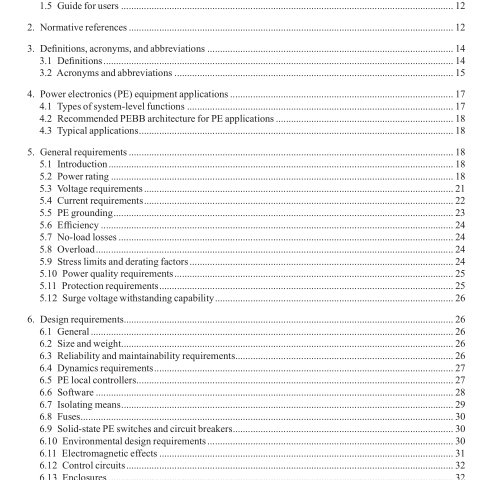IEEE 1662-2016 pdf download.IEEE Recommended Practice for the Design and Application of Power Electronics in Electrical Power Systems
3. Defnitions, acronyms, and abbreviations
3.1 Defnitions
For the purposes of this document, the following terms and defnitions apply. The IEEE Standards Dictionary Online should be consulted for terms not defned in this clause.
active fltering: Controlling power quality without impacting primary control of system voltage. energy storage
system (ESS): System that is capable of absorbing energy, storing it, and dispatching the en- ergy back into the power system. fault: An abnormal condition exceeding designated limits and which warrants immediate shutdown of the entire system. Faults often lead to cascading systems failure if not addressed correctly.
integrated power system (IPS): A power system where all prime movers are used to produce electrical power that is shared among propulsion, mission, microgrids, or service loads. Discriminating attributes of IPSs are fexibility of arrangements, mechanical decoupling between prime movers and propulsors, an increased level of energy conversion and transmission redundancy, and fexibility of redistributing available electrical power for future electrical loads.
land-based (offshore) power systems: Power systems installed on the land as distinguished from being in deep or open waters.
line replaceable unit (LRU): A modular component designed to be replaced quickly at location.
ow voltage: Rated 1000 V (ac) or 1500 V (dc) and below.
marine (offshore) power systems: Power systems with multiple power sources installed on ships, boats, mobile, and fxed offshore units.
medium voltage (MV): Rated above 1000 V (ac) or 1500 V (dc) and less than or equal to 52 kV.
per unit (PU): The reference unit, established as a calculating convenience, for expressing all power system electrical parameters on a common reference base.
One PU is 100% of the base chosen. power electronic building block (PEBB): A generic building-block concept for power electronics that incorporates standard modules that can be quickly confgured to meet the specifc hardware and software needs of particular applications.
power electronics (PE): Single device or system utilizing power semiconductors for conversion, switching, protection, and distribution of electrical power. protecting: Mitigating effects from fault currents, overvoltages, or loss of power source. resistance grounded: Grounded through impedance, the principal element of which is resistance, to limit current to the ground. solidly grounded: Connected directly to ground through an adequate ground connection in which no impedance has been inserted intentionally. sourcing: Converting power from one or more voltage or frequency levels while being in control of the output voltage or current (or phase angle in the case of alternating current) at its electrical output terminals.
ungrounded: A system, circuit, or apparatus without an intentional connection to ground, except through volt- age-indicating or measuring devices, or other very high impedance devices. zonal distribution: Electrical power architecture structured by zones where a zone is a logical and physical grouping of generation, storage, or consumption assets arranged in a common neighborhood. Zones with gen- eration or storage may be operated for periods of time independently from the power system. A zone is the smallest logical and physical grouping of assets.
3.2 Acronyms and abbreviations
2-D two-dimensional
3-D three-dimensional
ac alternating current
AFE active front end
BSES backup stored energy system
dc direct current
EMC electromagnetic compatibility
EMI electromagnetic interference
EMP electromagnetic pulse
ESS energy storage system
HMI human machine interface
HRG high resistance grounding
HSSB hybrid solid-state breaker
IGBT insulated gate bipolar transistor
IPS integrated power system
LAN local area network
LRU line replacement unit
LV low voltage
MTBF mean time between failures
MTTR mean time to repair
MV medium voltage
MVDC medium voltage direct current
NEC National Electric Code ® (NEC ® ) (NFPA 70)
PE power electronics
PEBB power electronic building block
PU per unit
PWM pulse width modulation
QOS quality of service
SCR silicon controlled rectifer, thyristor
SMES superconducting magnetic energy storage
SSCB solid-state circuit breaker
SSSS solid-state soft starter
STS solid-state transfer switch
SVARC static VAR compensator
TCR thyristor controlled rectifer
TPDR traction power diode rectifer
TRD total rated-current distortion
UPS uninterruptible power supply
VAR volt-amp reactive
VFD variable frequency drive
VSC voltage source converter
VSI voltage source inverter.IEEE 1662 pdf download.IEEE 1662-2016 pdf download
IEEE 1662-2016 pdf download

Leave a Reply